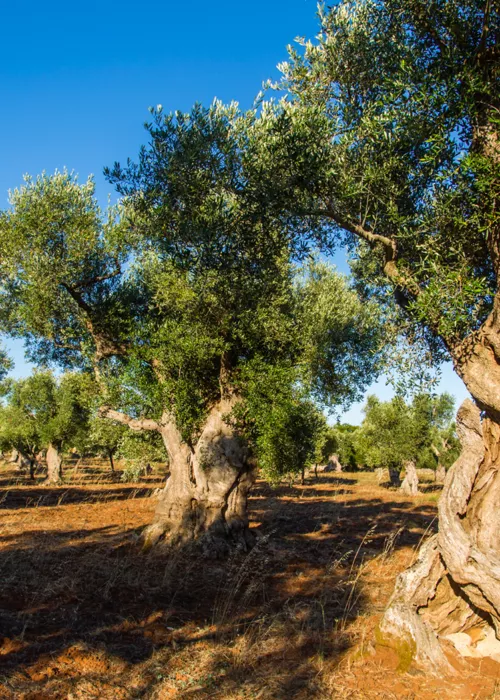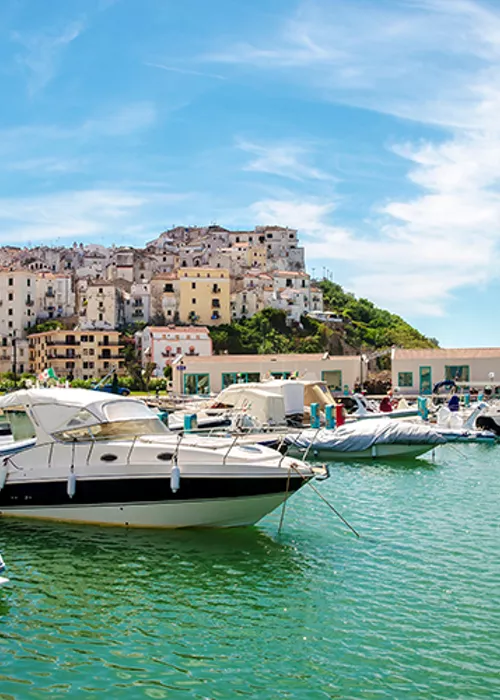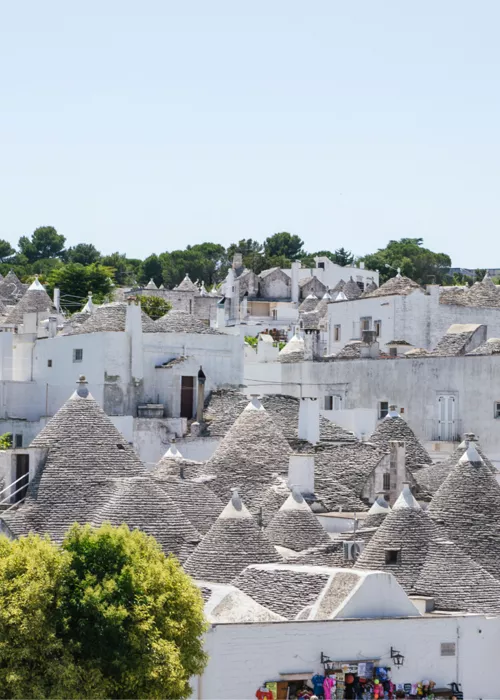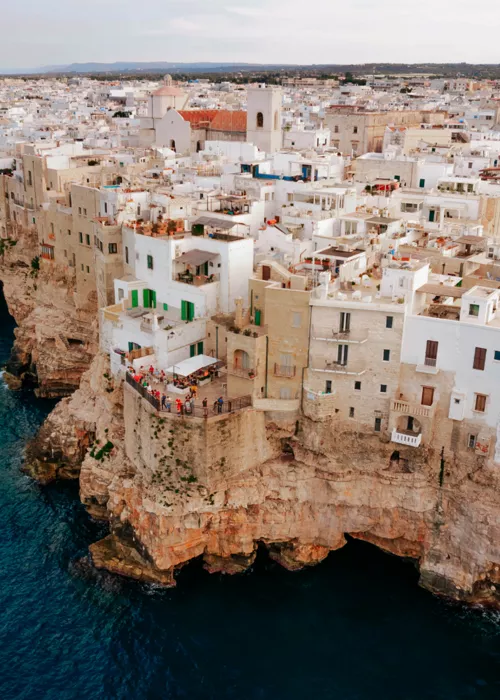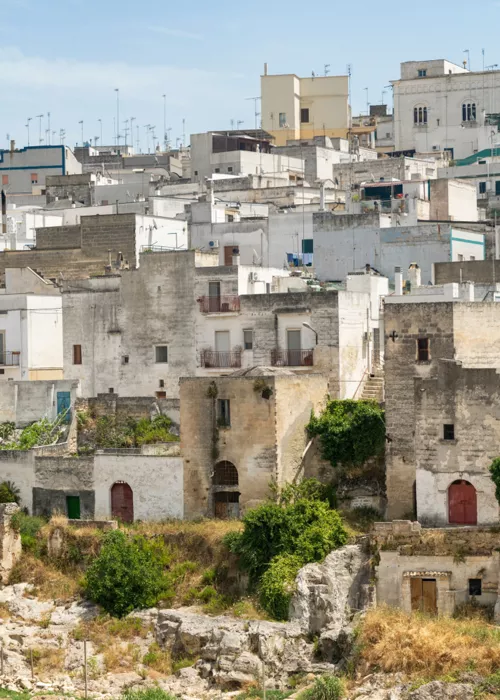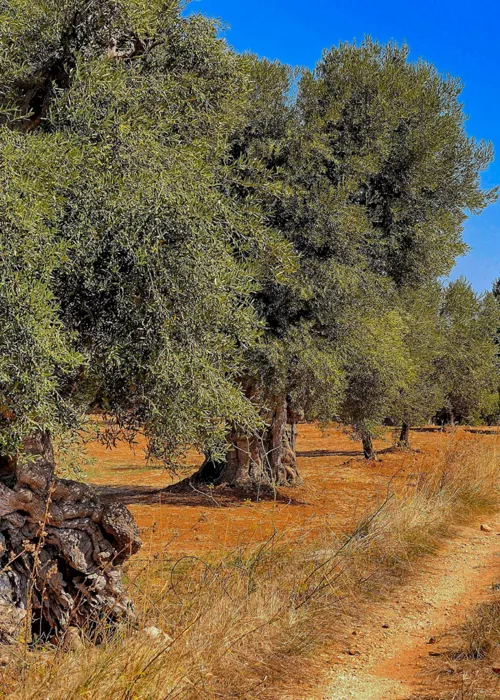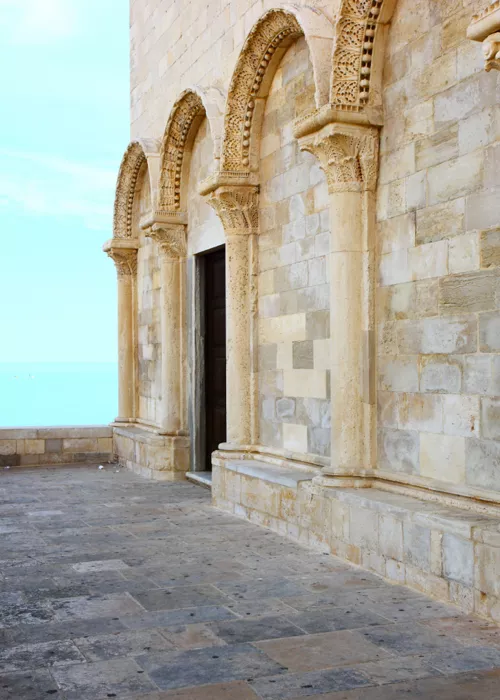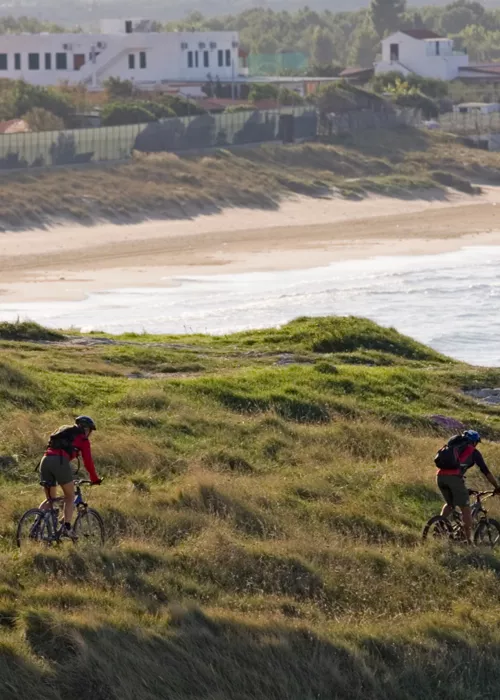From Lecce to Sternatia

Along the Rotta del Levante or Eastern Route, the Tourist Port of San Foca welcomes visitors to one of the most picturesque places in Salento. San Foca, a fishing village with narrow streets, white houses, sea caves, and genuine Salento hospitality. From San Foca, along the 24 km of the Sea Route of the Cammino del Salento, you can reach Lecce, famous for its splendid Baroque architecture. The city can also be reached by public transport. The starting point of the Route of Villages on the Cammino del Salento is Porta Napoli, the first stamp on the Pilgrim's Passport and the entrance to the historical centre, where you can admire Palazzo dei Celestini and the Basilica of Santa Croce, Piazza Sant'Oronzo, the Roman amphitheatre and the castle. Following the orange arrow, you leave the town along side-roads and reach San Cesario, with its distilleries and the Ducal Palace, rich in mythological statues. Before reaching San Donato, you will come across the Madonna della Giggiola chapel in the middle of the road! At the gates of Galugnano, among noble palaces, “pagghiare” and menhirs, is the church of the Madonna della Neve, a glimpse of the unspoilt Middle Ages. The itinerary continues to Sternatia, the town with the highest percentage of Griko speakers, where you can visit the 15th century hypogeum oil mill, a space rich in tunnels and galleries, once used for the production of olive oil for food and non-food purposes.
From Sternatia to Corigliano d’Otranto

The itinerary continues to Soleto and the Church of Santo Stefano, an example of the coexistence between Salento and the East. You pass through Galatina, the town of pasticciotto: don't miss the Basilica of Santa Caterina d'Alessandria. Following the path marked with orange arrows, you arrive in Corigliano d'Otranto, where the stage ends at the imposing Castello de' Monti and the Mother Church of Saint Nicholas, with its floor mosaic of the Tree of Life. A few kilometers from Corigliano d'Otranto, in the municipality of Castrignano De' Greci, lies the Park of the Pozzelle, one of the largest and best preserved areas in the region, covering about 8,000 square metres near the town centre. In this park there are about a hundred pozzelle (wells), known in Griko as "ta fréata", which are water reservoirs 4 to 6 metres deep, with a shape similar to an inverted funnel. The pozzelle were dug into the fragile rock in a natural depression in the land and are covered with permeable limestone. This system allows rainwater to filter through the stone and fill the cavities below. At the top of each pozzella there is a block of stone with a central hole, called an "uccale", through which buckets can be lowered to collect water. Next to the pozzelle are some stone troughs used for watering animals. The custom of digging these wells in hollows dates back to the Byzantine period, and similar examples can be found in Greece. Today, Pozzelle Park is used for recreational activities, events and concerts. It has hosted one of the stages of the Notte della Taranta, the travelling festival dedicated to the folk music of Salento.
From Corigliano d’Otranto to Otranto

Following the orange arrow you will reach Melpignano with the church and the convent of the Augustinians, Palazzo Marchesale and the porticoes of Piazza San Giorgio, then you will come close to the quarries where the famous Lecce stone, Cursi, is extracted. Here you can admire Palazzo Maramonte, a baronial castle that is now the town hall, and visit an underground oil mill, made even more interesting thanks to the use of special VR (virtual reality) viewers that provide a completely immersive experience. Continuing along the itinerary and passing through Bagnolo del Salento, you will come to the Montevergine Sanctuary in Palmariggi, whose origins date back to 1595, when the Madonna appeared to a shepherd who had lost his knife while cutting a branch. Then you reach Giurdignano , the megalithic garden of Italy, with its dolmens and menhirs. Through the Selva del Turchese and the Val d'Idro, you reach the splendid town of Otranto, overlooking the Adriatic Sea, which will be your companion until the end of the Cammino del Salento.
From Otranto to Santa Cesarea Terme

Just outside Otranto is the start of the most picturesque part of the Cammino del Salento, offering a spectacular trek along the coast. The route leads first to the Torre del Serpe, perched on a cliff overlooking the sea, and then to the famous lake formed in the old bauxite quarry. The route continues to the Palascìa lighthouse, the most easterly point in Italy, which offers an incomparable view of the Adriatic, especially at dawn, and then to Porto Badisco, the first landing place of Aeneas described in Virgil's Aeneid, famous for its crystal-clear waters and the Grotta dei Cervi. Following the path and the Appian Way of the Calabro Salentina, passing by the Masseria Grande, you will reach Santa Cesarea Terme, where you will receive a beautiful stamp for your Pilgrim's Passport! The town is famous for its sulphurous thermal waters; in the historical centre stands Villa Sticchi, a Moorish-style building that adds an oriental touch to the landscape.
From Santa Cesarea Terme to Marina Serra

Following the orange arrow, you will reach the bay of Porto Miggiano, characterised by crystal-clear water and white rocks, and then Castro, the pearl of Salento: in the heart of the village stands the Aragonese castle, where you can get a stamp for your pilgrim's pass. From Castro Marina, along paths and ancient trails, you can reach Cala dell'Acquaviva di Marittima, a bay rich in cold water springs and surrounded by luxuriant vegetation. Past the Cala, follow the Belvedere path, then the Serra del Mito path, passing Torre Del Sasso and the Seven Pajare, to reach Tricase Porto. Following the coastal road, you arrive at Marina Serra, famous for its magnificent natural swimming pool.
From Marina Serra to Santa Maria di Leuca

The last stage begins on the Sentiero del Nemico to reach the Baronial Palace of Tiggiano. From the courtyard you can enter a splendid garden with an orchard and a dovecote. Then you reach Corsano and its hypogeum oil mill, then Marina di Novaglie, where the spectacular Sentiero delle Cipolliane begins, suspended on the border between land and sea, leading to the Ciolo inlet. The two highest cliffs are connected by a large bridge (Ponte Ciolo), 40 metres above sea level. Along a path full of caves and cliffs, you can reach Gagliano del Capo and continue along side-roads until you reach “Erma Antica”, where the ancient ritual of the pilgrim stone is performed. At the foot of the monumental waterfall of Santa Maria di Leuca, 284 steps separate you from the Sanctuary of Santa Maria de Finibus Terrae, the final destination of the Cammino del Salento.



